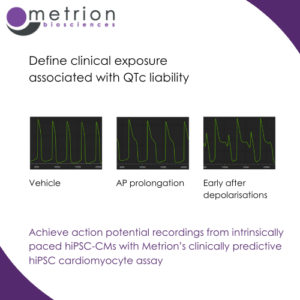Understanding cardiac safety early is critical in drug development. In their latest poster, Jazz Pharmaceuticals, explain how they utilised Metrion’s clinically translatable cardiotoxicity assay to do exactly that.
 Early cardiac derisking: A clinically translatable hiPSC cardiomyocyte assay
Early cardiac derisking: A clinically translatable hiPSC cardiomyocyte assayAchieve action potential recordings from intrinsically paced hiPSC-CMs with Metrion’s clinically predictive hiPSC cardiomyocyte assay.
Read more about our hiPSC cardiomyocyte assay.
Understanding cardiac safety early is critical in drug development. In their latest poster, Jazz Pharmaceuticals, explain how they utilised Metrion’s clinically translatable cardiotoxicity assay to do exactly that.
Aligos Therapeutics and Metrion explore key approaches to cardiovascular safety screening in drug discovery.